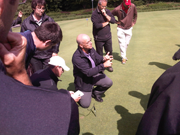
Features
Agronomy
Turf clinic turns agronomic gadgets into agronomic magic
October 10, 2012 By Mike Jiggens
Syngenta Canada Inc. recently partnered with O.J. Compagnie in Quebec
to conduct a series of turf clinics for golf course superintendents in
the region.
The primary focus was “game changing gadgets” and “essential techniques for success.”
Benoit Huot, O.J. vice-president of agronomy, and Ryan Beauchamp, Syngenta turf specialist, collaborated on many industry concerns and executed this one-of-a-kind workshop with precision.
The nearly 40 participating superintendents at two venues started each session with a group review of the most recent industry strategies report on anthracnose management, authored by Dr. Bruce Clark and his Rutgers team.
Attendees were particularly interested with the 60-80 per cent ET rate listed as crucial to successful management of this troubling disease. Conversations transitioned smoothly into proper irrigation management that starts with computer models that can be generated each day on their respective irrigation central programs.
“If you plug in a plant coefficient factor of 65 per cent for greens height turf, projections for your daily ET rates can easily be determined by simply using daily weather forecast for your site,” Beauchamp said.
Ronald Begin, course superintendent at Blainvillier Golf Club, commented that he appreciated the opportunity to actually test drive numerous volumetric moisture meters on hand that were set at variable depths for a variety of troubleshooting scenarios. A rundown of do’s and don’ts progressed into identification of various hand irrigating practices that are required in different situations, and appropriate hose nozzle selection to perform these crucial tasks.
A hand-watering clinic performed by Beauchamp created much discussion amongst the superintendents as they determined if they wanted to irrigate deeply, or simply allow the plant to respire by fogging the green surface and not wet the soil. On display were many hand-held hose guns ranging from four gallons per minute to more than 50 gallons per minute for the audience to select.
“When an operation utilizes only one type of nozzle to irrigate, turf performance will likely be compromised,” insisted Beauchamp.
Huot continued the clinic by demonstrating a Spectrum technologies field scout EC meter which is used for testing sodium issues tied up in the soil. He explained the negative effect poor water quality can create and how it can often be magnified by selecting certain fertilizers and even surfactants.  Discussed at great lengths were concerns with high concentrations of total dissolved salts and sodium which can significantly impact the turfgrass ecosystem and may result in dead grass.
Discussed at great lengths were concerns with high concentrations of total dissolved salts and sodium which can significantly impact the turfgrass ecosystem and may result in dead grass.
Eric Rondeau, superintendent at the municipal golf club of Longueuil, appreciated the explanations of proper sprayer setup for specific disease management and the process of self-testing the sprayers’ computer with various nozzles.
The group quiz on appropriate boom height and spray nozzle spacing hit the target with participants. Alan Morton, superintendent at Griffon des Sources Golf Club, applauded the game-changing efforts of Syngenta’s innovative fairway nozzle system to assist in “making your sprayer invisible” through fewer tanks being applied and better efficacy of products. Numerous sprayers and nozzle types were on hand for participants to discuss.
A turf prism was available for participants to better understand the variable heights of cuts when different manufactures are used. The bench setting of a floating head mower vs. fixed head unit may be the same, but the true height of cut can vary greatly. This can lead to inconsistent playing conditions and at times disease outbreaks like anthracnose that could easily be avoided.
Participants also found the prism to be an essential tool to identify the need to perform certain cultural practices such as verticutting, topdressing or brushing. Beauchamp demonstrated that although the middle of the green showed a .115 height of cut with the prism, the turf at the green perimeter was actually laying down. When this area was hand brushed, the prism showed the true height of the green perimeter to be more than .250.
The clinic provided an ideal opportunity for superintendents to network and play in the field with the many new cutting-edge tools available today. The clinics were so well received that Syngenta and O.J. have agreed to continue again in the Mount Tremblant area. It was also hinted Syngenta may continue its clinic in other provinces in the near future.
Print this page